Calculate ΔrG at 298 K for the following reaction if the reaction mixture consists of 1 atm of N2,3 atm of H2 and 1 atm of NH3.N2(g)+3H2(g)⇔2NH3(g),ΔrGΘ=−33.2kJ
To calculate the Gibbs free energy change (ΔG) for the given reaction at 298 K, we can use the following equation:
ΔG=ΔG∘+RTlnQ
1. Identify the Reaction and Given Data:
The reaction is:
N2(g)+3H2(g)⇌2NH3(g)
Given:
- ΔG∘=−33.2kJ
- Partial pressures: PN2=1atm, PH2=3atm, PNH3=1atm
- Temperature T=298K
2. Calculate the Reaction Quotient (Q):
The reaction quotient Q is calculated using the formula:
Q=(PNH3)2(PN2)(PH2)3
Substituting the given values:
Q=(1)2(1)(3)3=127
3. Convert ΔG° to Joules:
Since R is in Joules, convert ΔG∘ from kJ to J:
ΔG∘=−33.2kJ=−33200J
4. Use the Ideal Gas Constant (R):
The value of R is:
R=8.314J/(mol K)
5. Calculate ΔG:
Substitute the values into the ΔG equation:
ΔG=ΔG∘+RTlnQ
ΔG=−33200J+(8.314J/(mol K))(298K)ln(127)
6. Calculate RTlnQ:
First, calculate ln(127):
ln(127)=−ln(27)≈−3.2958
Now calculate RTlnQ:
RTlnQ=(8.314)(298)(−3.2958)≈−8155.5J
7. Final Calculation of ΔG:
ΔG=−33200+(−8155.5)≈−41355.5J
Converting back to kJ:
ΔG≈−41.36kJ
Final Answer:
ΔG≈−41.36kJ
The reaction is:
N2(g)+3H2(g)⇌2NH3(g)
Given:
- ΔG∘=−33.2kJ
- Partial pressures: PN2=1atm, PH2=3atm, PNH3=1atm
- Temperature T=298K
The reaction quotient Q is calculated using the formula:
Q=(PNH3)2(PN2)(PH2)3
Substituting the given values:
Q=(1)2(1)(3)3=127
Since R is in Joules, convert ΔG∘ from kJ to J:
ΔG∘=−33.2kJ=−33200J
The value of R is:
R=8.314J/(mol K)
Substitute the values into the ΔG equation:
ΔG=ΔG∘+RTlnQ
ΔG=−33200J+(8.314J/(mol K))(298K)ln(127)
First, calculate ln(127):
ln(127)=−ln(27)≈−3.2958
Now calculate RTlnQ:
RTlnQ=(8.314)(298)(−3.2958)≈−8155.5J
ΔG=−33200+(−8155.5)≈−41355.5J
Converting back to kJ:
ΔG≈−41.36kJ
ΔG≈−41.36kJ
Similar Questions
Calculate ΔrGΘ at 298K for the following reaction if the reaction mixtur econsists of 1atm of N2,3 atm of H2, and 1atm of NH3.
N2(g)+3H2(g)W⇔2NH3(g),ΔrGΘ=−33.32kJ
View SolutionCalculate ΔG at 298 K for the following reaction if the reaction mixture consists of 1 atm of N_(2),3 atmofH_(2)and1atmofNH_(3).<br>N_(2)(g)+3H_(2)(g) hArr 2NH_(3)(g),DeltaG^(0)=-33.32 kJ
What is the effect of increasing pressure on the reaction ?
View Solution
Knowledge Check
For the reaction
N2(g)+3H2(g)⇔2NH3(g),ΔH=?AΔE+2RTBΔE−2RTCΔE+RTDΔE−RTKC for the reaction 12N2(g)+32H2(g)⇔NH3(g) is
AKc=[NH3][N2][H2]BKc=[N2][H2][NH3]CKc=[NH3][N2]12[H2]32DKc=[N2]12[H2]32[NH3]The % yield of ammonia as a function of time in the reaction N2(g)+3H2(g)⇔2NH3(g),(g)ΔH<0 at (P,T1) is given below
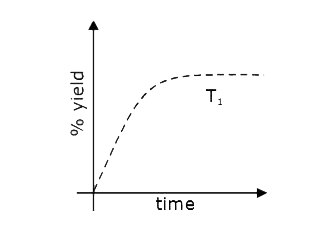 A
A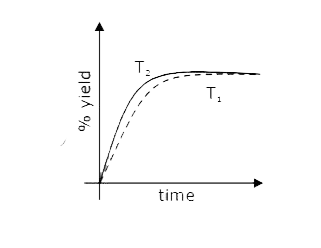 B
B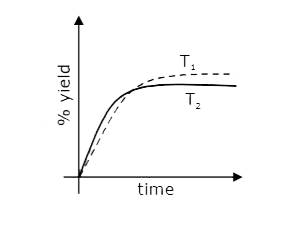 C
C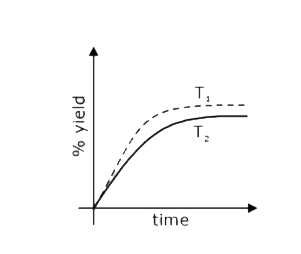 D
D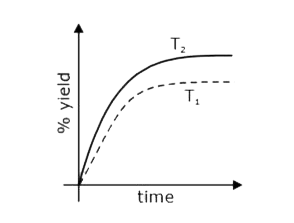
For the reaction, N2(g)+3H2(g)⇔2NH3(g), the units of Kp are …………
View SolutionWrite the relation between Kp and Kc for the reaction:
N2(g)+3H2(g)⇔2NH3(g)
View SolutionWhich of the following is correct for the reaction?
N2(g)+3H2(g)⇔2NH3(g)
View SolutionWhich of the following is correct for the reaction?
N2(g)+3H2(g)⇔2NH3(g)
View SolutionFor the chemical reaction
N2(g)+3H2(g)⇔2NH3(g)
The correct option is:
View Solution
